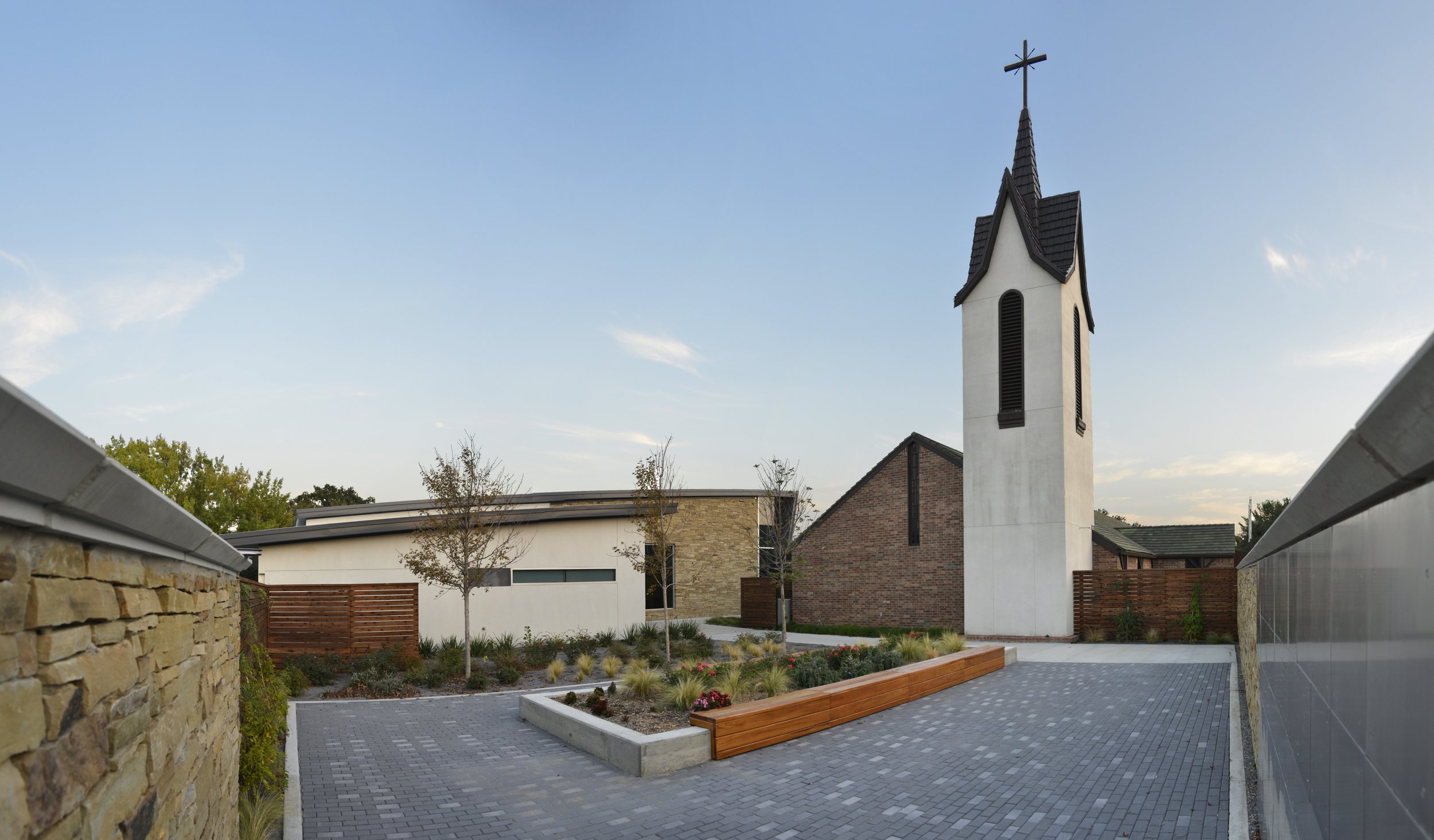
Art & Architecture
Since the Episcopal Church of the Redeemer was planted in a quiet, north Irving residential neighborhood, in an aging Normandy styled manor house, there has always been a growing vision for our campus. Today our church grounds are home to three buildings in which we carry out our mission of worship, discipleship and service. As the setting for our liturgy and worship, our sanctuary is contemporary in design featuring broken cross beams between the modern stained glass windows on the exterior and huge rugged exposed beams on the interior to recall the French Provincial architecture of the original building. Except for an expansion to the north end of the church and the addition of the bell tower, the building looks much as it did at its dedication in 1965. The result is a cool comfortable feel that makes the church a wonderful place for worship and a peaceful place to spend some quiet moments.

















Story Hall, dedicated in 2002, is home to the Redeemer Montessori School. Simple in its design, it also bears touches of French Provincial architecture with the broken crosses made from its brick columns and dark wooden roof supports at its main entrance and across its back porch.
Ware Hall, which opened in the fall of 2013, contrasts with the other two buildings, in that it is modern in design with an emphasis on light and airiness. As you enter the foyer, you cannot help but notice the large west window that looks out upon the Columbarium and Prayer Garden. The high ceiling and glass wall that separate the foyer area from the conference room adds even more to the feeling of openness. Looking closely at the glass wall you will see the massive metal cross that has been incorporated into the structure of the wall, giving a spiritual presence to the room. When you walk into the fellowship hall, you are again hit with the feeling of spaciousness. The south wall, made up completely of glass, looks out onto a large porch and the courtyard, making the room feel larger than it actually is. High vaulted ceilings and beautiful oak beams add even more to the feeling of open space. This beautiful building serves both the church and school. The church offices, nursery, and the school's toddler program are housed here, as are the school's music, science, and physical education programs. The school's after school program is housed here as well.
Our Columbarium and Prayer Garden were added during construction of the parish hall. They were designed as a memorial to past parishioners and a place for the ashes of loved ones to rest peacefully. The central raised flower bed flanked by polished wooden benches and the plants that surround the outer edges of the garden make it a perfect place for reflection and escape from the busy world outside its walls. Our first internments took place in May, 2014.
Art abounds within the church and its grounds, but sometimes you have to look carefully in order to not miss it. An example of this would be the front of the church's original altar which can be found in the east narthex of the church. You could easily overlook the wooden altar mounted on the east wall of the narthex and the contemporary symbols of the seven sacraments of the church across its front panel. These paintings were done by Wayne Amerine, a member of the church and a local artist. His work can also be seen on the bishop’s chair adjacent to the altar, and one of his paintings, entitled Father and Child, hangs in the Dallas Museum of Art.
Turning toward the front of the sanctuary, your eyes are immediately drawn to the Christus Rex which hangs above the altar. This Christus Rex, or Christ the King, was hand carved in Genoa, Italy, and has hung behind the altar since the dedication of the building in 1965. It was given to the church by its first rector, Father Joe Hollifield. The reredos, or wall behind the Christus Rex, was designed and built by Waldo Cecil, a member of the church, to celebrate the church's 25th anniversary.
The reredos contains four large radians symbolizing the cross. From behind Christ's head, 365 textured beams radiate representing the days within the church year. Twelve major radians recall the twelve apostles and another 40 fan and sunken radians are symbolic of the 40 days of the Lenten season.
Over the years church members have donated additional pieces to accentuate our sacred space.
The Stations of the Cross, typically used during Lent, adorn the east and west walls in the main area of the church. They were a gift from Cara Ingram. During special holy days, we use pew candles donated by Dick and Mary Beth Comstock to give the church a special glow.
There are several pieces of needlework in the church, also. Pam Cary, Angie Litchfield, Lori Brockett and Kathy Ulmer did the needlepoint on the Redeemer banner that was designed by Ann Savage. The needlepoint piece that hangs above the priest’s bench and the pillow on the seat of the bishop’s chair were done by Roberta Bergman.
The parish hall also houses a few additional art features. The painting “Joseph, Son of True Colors” is acrylic on canvas (2015), and was painted by Ann Savage. It was commissioned by Danielle Perkins and donated to the church. The beautiful reception desk in the foyer reflect the pattern of the cross in the glass between the foyer and the conference room. It was designed and built by Richard Wilson. One last piece of art remains. As you move toward the Prayer Garden, just north of the church, you will pass a statute of the Madonna. This piece was originally the center of a garden that stood in the courtyard area since 1992. With the construction of the parish hall, the garden was removed to make way for improved sidewalks and the Madonna was moved to its present location. Here she stands greeting those who enter the Prayer Garden for a time of rest and reflection, holding in her arms a reminder of God's most precious gift to us, his Son.



